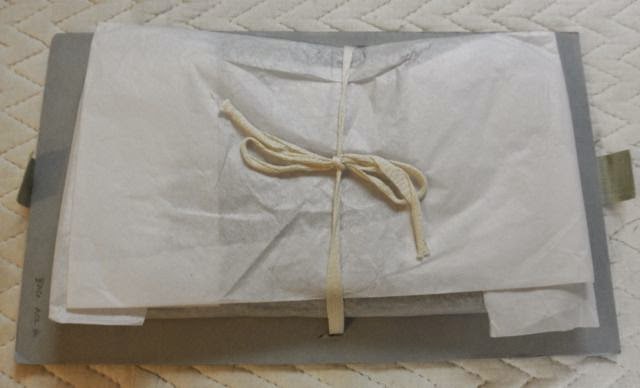 |
| The beaded vamp of the moccasin before treatment. |
 |
| The underside of the vamp before treatment. Here you can see that the wool layer (which should be between the leather and the vamp) is missing. The small dark regions are the moth casings. |
Traditionally, when a moccasin like this was being made, the glass beads were sewn to sandwiched pieces of paper and leather that would make up the decorative pieces of the vamp and cuff. These parts of a moccasin were typically embellished separately before being attached to the moccasin. To cover the backside of the stitching of the beads, a wool layer was commonly used to line these sections. In the case of this moccasin, the wool layer is missing, because it had been breakfast, lunch, and dinner for some hungry webbing clothes moths. Delicious!
These little, but incredibly voracious bugs have long departed from this moccasin, leaving behind the remnants of their stay: the casings in which they morphed from larvae to moth. Like most infestations, there is no simple way to know when this infestation occurred. What is important now is that the infestation is inactive. However, as evidenced from the amount of casings found, these moths certainly were very happy when they were here.
 |
| The lifecycle of a moth. |
You may wonder what it was about this location (i.e. under the vamp) that made the moths so content to stay. Webbing clothes moths (and other pests) prefer to be left alone and undisturbed. They also really like dark locations, and if the location is slightly damp and warm, it is even that much better! The fascinating part here is that webbing cloths moths also like to graze the surface of semi-tanned leather, but in this case there is no evidence of this type of damage. Therefore they were content with the wool alone.
From the exterior of this particular pair of moccasins, you would not be able to detect what was within the layers below the surface. However, being aware of the placement of the wool layer both under the vamp and cuff, and knowing that it provided a paradise location for pests, helps to understand safe storage/collection management for this particular artifact in the future.
So how do you prevent this type of damage from occurring with your artifacts? You need to practice IPM, otherwise known as Integrated Pest Management. The basic philosophy of IPM is to make your environment as inhospitable to pests as possible and to avoid the use of chemicals (read our recent post on moth balls). An inhospitable environment can be accomplished with these simple steps:
1. Inspect and "disturb" your artifacts regularly, particularly those that might be enjoyed most by pests.
2. Treat your vacuum as your best friend and use it often.
3. A cold and dry location is the best location to store your artifacts.
It is always best to avoid pest problems rather than reacting to infestation. Remember the motto of IPM:
"Prevention is better than cure"
If you want to know more about museum pest management check out this website: http://museumpests.net
And if you cannot help but find humor in museum pest management, you must see Historic Cherry Hill's youtube video to better understand the insect's point of view!
_____________________________
Gwen Spicer is a textile conservator in private practice. Spicer Art Conservation specializes in textile conservation, object conservation, and the conservation of works on paper. Gwen's innovative treatment and mounting of flags and textiles is unrivaled. To contact her, please visit her website.





